contributed by Lizette Royer Barton.
While working in the Walter and Catharine Cox Miles papers recently I came across a string of correspondence from 1928 between Walter Miles and Margaret Floy Washburn in which they reference a “motion picture film taken at Carlisle.”
I’ve always known this film as the “Titchener Film” due to the first two minutes taken at the 1927 meeting of the Experimentalists but there are 11 minutes of footage post Titchener and it’s really good stuff.
This blog was supposed to be a fluff piece for Women’s History Month to show Margaret Floy Washburn on film. But instead, and you know this is coming if you’ve read any of my contributions to this blog, I went down the rabbit hole….
I Googled, experimental psychology + Carlisle and the second hit was a 2010 History of Psychology journal article by my friend Jim Goodwin titled, “The 1928 Carlisle conference: Knight Dunlap and a national laboratory for psychology.”
And a bonus – on page 379 he appears to reference the film in question, “…a brief film, with most scenes featuring Margaret Washburn walking around the Dickinson College campus in the company of various clusters of male attendees.”
I watched the film and noticed this.
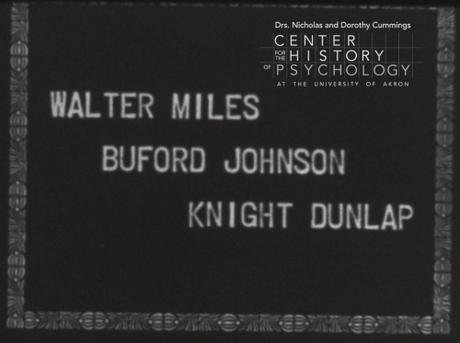
Walter & Catharine Cox Miles papers, Film 5-5
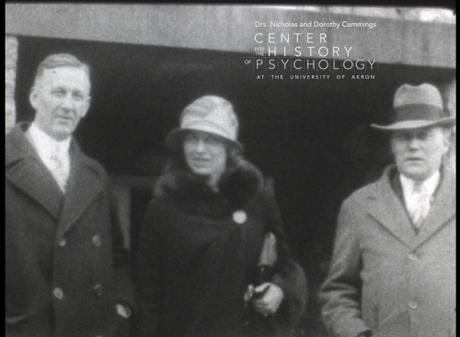
Walter & Catharine Cox Miles papers, Film 5-5
Johnson…Johnson…that name was familiar….
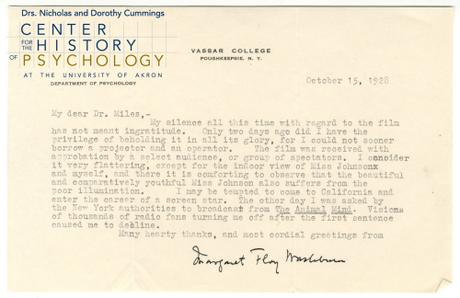
“I consider it [the film] very flattering, except for the indoor view of Miss Johnson and myself, and there it is comforting to observe that the beautiful and comparatively youthful Miss Johnson also suffers from the poor illumination.” Walter & Catherine Cox Miles papers, M1121, folder 13
.the only woman invited to the Carlisle meeting….I pulled the 1928 APA Directory (the year of the Carlisle Conference) from our reference library and found Buford J. Johnson listed as an APA member. Johnson was at Johns Hopkins (as was Knight Dunlap – organizer of the Carlisle Conference) and experimental psychology was listed as an interest which would make sense for a psychologist attending a conference centered around the creation of a National Laboratory of Experimental Psychology.
But then I noticed Johnson was a graduate of LaGrange College.

Wait a minute? Wasn’t LaGrange a women’s college? Wikipedia confirmed my suspicions. LaGrange was a women’s college until 1934 and Johnson earned an A.B. in 1895.
A quick google search of “Buford Johnson” + LaGrange and I was rewarded with a fantastic blog by two LaGrange College librarians titled, “Interesting Alumni: LC’s Extraordinary Women of the Past.”
Extraordinary WOMEN of the past? Was Buford J. Johnson a woman?!
I went back to the APA directories and started leafing through all of them until I hit pay dirt in 1948.
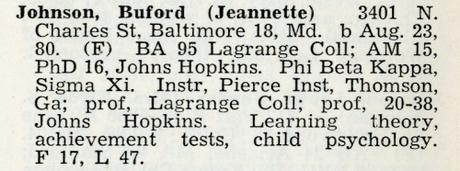
It turns out Dr. Buford Jeannette Johnson earned her PhD at Hopkins in 1916 and in 1924 became the first woman to be appointed professor of psychology in the department. She was also the founding editor of the journal Child Development and the first woman to be elected president of the Southern Society for Philosophy and Psychology.
I did a search across our collections for Buford Jeannette Johnson and besides the film and letter in which she is mentioned in the Miles papers there was only one other hit – a postcard from 1929 from Johnson to Sarah Dunlap (Knight Dunlap’s daughter) in the Knight Dunlap papers.
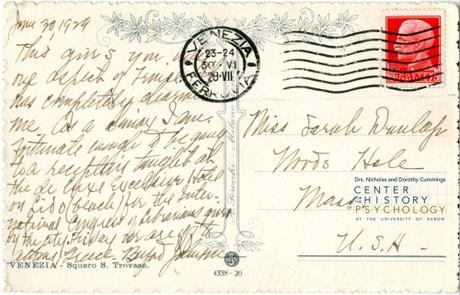
“I am…going to a reception tonight… for the International Congress of LIBRARIANS.” International Congress of Librarians? Oh my goodness! Buford Johnson is too good to be true! Knight Dunlap papers, M569, folder “Postcards”
Buford Jeannette Johnson died in 1954 at the age of 74. Her death certificate, located by my genealogical-research savvy colleague Dr. Jodi Kearns, indicates Johnson died of acute nephritis with antecedent causes of cerebral arteriosclerosis and “nervous breakdown from excessive study.”
Reading her death certificate broke my heart a little bit. Realizing Dr. Buford Jeannette Johnson is darn near invisible in the history of psychology broke my heart a lot.
What are Buford Jeannette Johnson and Margaret Floy Washburn talking about in this film? Did their laughter stem from the gallows humor almost certainly necessary for women in the field of experimental psychology in the 1920s? Or maybe it was lighter than that. Maybe they were just friends. Or simply colleagues.
In any case, here are two incredibly talented and bright psychologists sharing a laugh.
